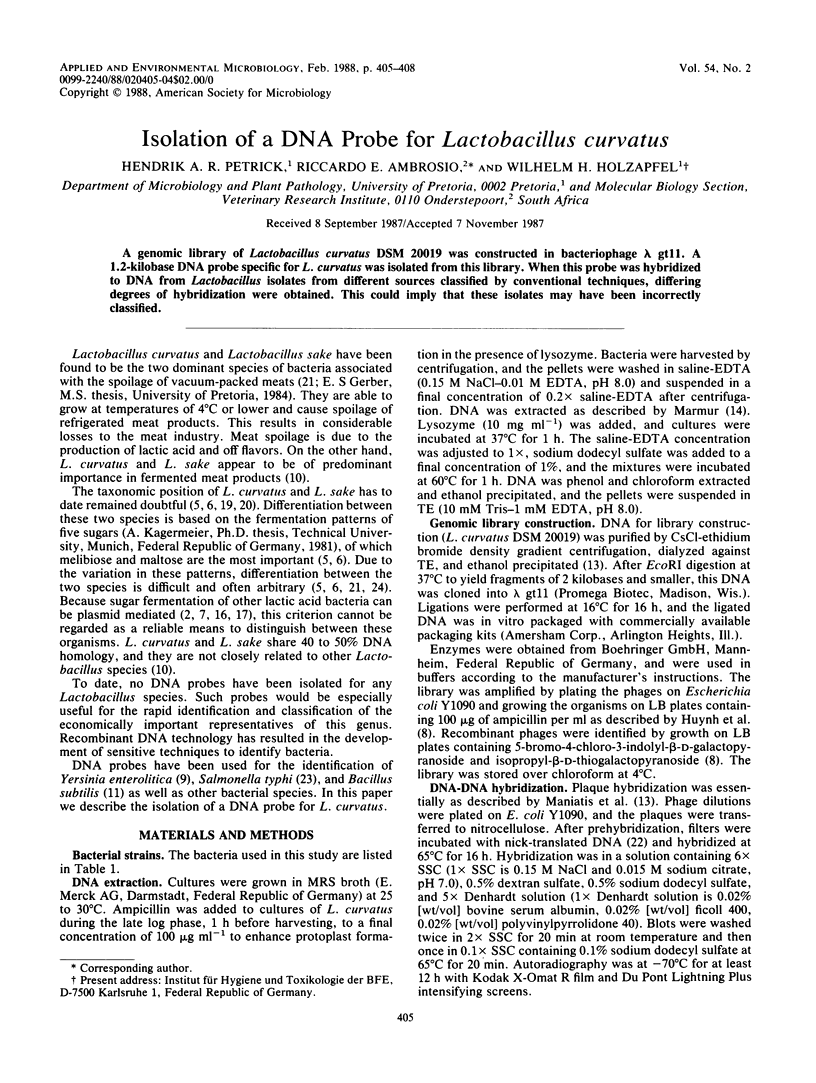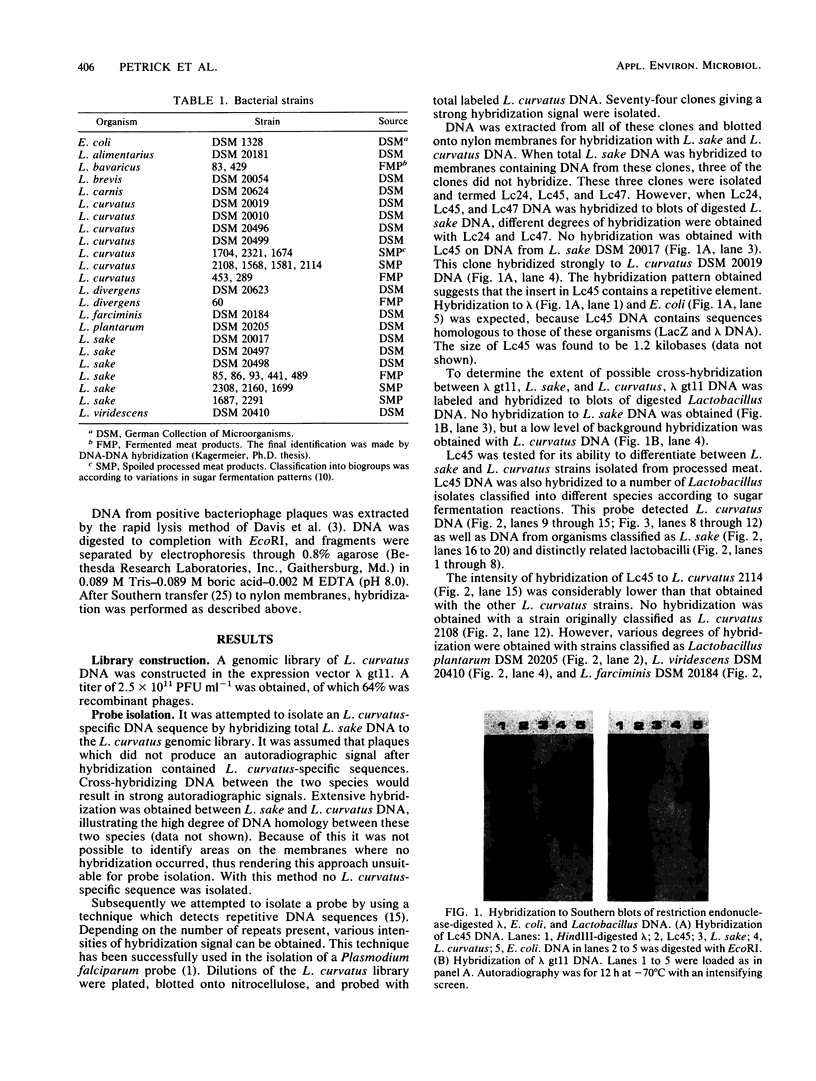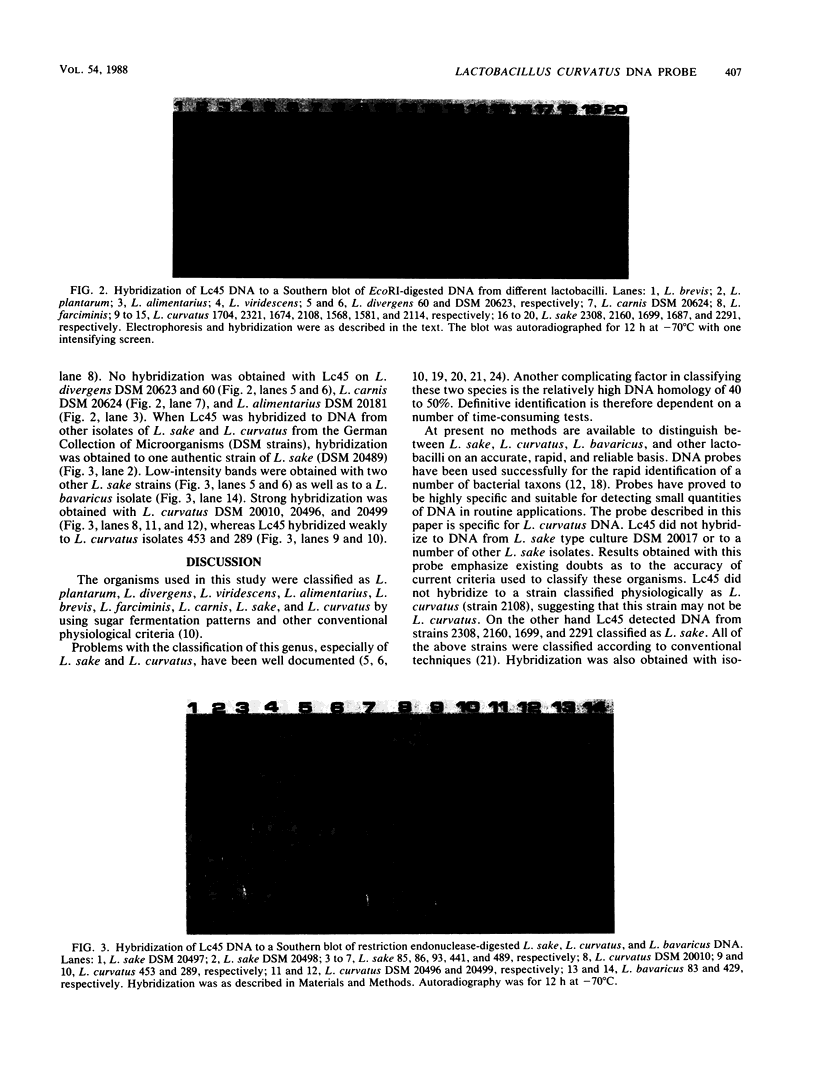Abstract
A genomic library of Lactobacillus curvatus DSM 20019 was constructed in bacteriophage λ gt11. A 1.2-kilobase DNA probe specific for L. curvatus was isolated from this library. When this probe was hybridized to DNA from Lactobacillus isolates from different sources classified by conventional techniques, differing degrees of hybridization were obtained. This could imply that these isolates may have been incorrectly classified.
Full text
PDF



Images in this article
Selected References
These references are in PubMed. This may not be the complete list of references from this article.
- Barker R. H., Jr, Suebsaeng L., Rooney W., Alecrim G. C., Dourado H. V., Wirth D. F. Specific DNA probe for the diagnosis of Plasmodium falciparum malaria. Science. 1986 Mar 21;231(4744):1434–1436. doi: 10.1126/science.3513309. [DOI] [PubMed] [Google Scholar]
- Franzén L., Westin G., Shabo R., Aslund L., Perlmann H., Persson T., Wigzell H., Pettersson U. Analysis of clinical specimens by hybridisation with probe containing repetitive DNA from Plasmodium falciparum. A novel approach to malaria diagnosis. Lancet. 1984 Mar 10;1(8376):525–528. doi: 10.1016/s0140-6736(84)90929-2. [DOI] [PubMed] [Google Scholar]
- Hastings J. W., Holzapfel W. H. Conventional taxonomy of lactobacilli surviving radurization of meat. J Appl Bacteriol. 1987 Mar;62(3):209–216. doi: 10.1111/j.1365-2672.1987.tb02400.x. [DOI] [PubMed] [Google Scholar]
- Jagow J., Hill W. E. Enumeration by DNA colony hybridization of virulent Yersinia enterocolitica colonies in artificially contaminated food. Appl Environ Microbiol. 1986 Feb;51(2):441–443. doi: 10.1128/aem.51.2.441-443.1986. [DOI] [PMC free article] [PubMed] [Google Scholar]
- Kuritza A. P., Getty C. E., Shaughnessy P., Hesse R., Salyers A. A. DNA probes for identification of clinically important Bacteroides species. J Clin Microbiol. 1986 Feb;23(2):343–349. doi: 10.1128/jcm.23.2.343-349.1986. [DOI] [PMC free article] [PubMed] [Google Scholar]
- McPheat W. L., McNally T. Isolation of a repeated DNA sequence from Bordetella pertussis. J Gen Microbiol. 1987 Feb;133(2):323–330. doi: 10.1099/00221287-133-2-323. [DOI] [PubMed] [Google Scholar]
- Rigby P. W., Dieckmann M., Rhodes C., Berg P. Labeling deoxyribonucleic acid to high specific activity in vitro by nick translation with DNA polymerase I. J Mol Biol. 1977 Jun 15;113(1):237–251. doi: 10.1016/0022-2836(77)90052-3. [DOI] [PubMed] [Google Scholar]
- Rubin F. A., Kopecko D. J., Noon K. F., Baron L. S. Development of a DNA probe to detect Salmonella typhi. J Clin Microbiol. 1985 Oct;22(4):600–605. doi: 10.1128/jcm.22.4.600-605.1985. [DOI] [PMC free article] [PubMed] [Google Scholar]
- Shaw B. G., Harding C. D. A numerical taxonomic study of lactic acid bacteria from vacuum-packed beef, pork, lamb and bacon. J Appl Bacteriol. 1984 Feb;56(1):25–40. doi: 10.1111/j.1365-2672.1984.tb04693.x. [DOI] [PubMed] [Google Scholar]
- Southern E. M. Detection of specific sequences among DNA fragments separated by gel electrophoresis. J Mol Biol. 1975 Nov 5;98(3):503–517. doi: 10.1016/s0022-2836(75)80083-0. [DOI] [PubMed] [Google Scholar]
- Wirth D. F., Pratt D. M. Rapid identification of Leishmania species by specific hybridization of kinetoplast DNA in cutaneous lesions. Proc Natl Acad Sci U S A. 1982 Nov;79(22):6999–7003. doi: 10.1073/pnas.79.22.6999. [DOI] [PMC free article] [PubMed] [Google Scholar]





